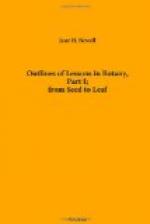How do they differ from the first pair?
PEA.
What are the parts of the seed? Compare it with
the Morning-Glory,
Sunflower, and Bean.
How does it differ in its growth from the Bean?
What have all these four seeds in common?
[Illustration: FIG. 7.—Germination of Pea. a, caulicle; b, cotyledons; c, plumule; d, roots.]
[Illustration: FIG. 8.—Germination of Bean.]
What has the Morning-Glory seed that the others have not?
What have the Bean and Pea that the Morning-Glory has not?
How does the Pea differ from all the others in its growth?
What part grows first in all these seeds?
From which part do the roots grow?
What peculiarity do you notice in the way they come up out of the ground?[1]
[Footnote 1: This question refers to the arched form in which they come up. In this way the tender, growing apex is not rubbed.]
The teacher must remember that, unless the pupils have had some previous training, they will first have to learn to use their eyes, and for this they will need much judicious help. They should be assisted to see what is before them, not told what is there. It is absolutely necessary that these questions should be thoroughly understood and correctly answered before any conclusions are drawn from them. For this purpose abundant material is indispensable. It is better not to attempt these lessons on seeds at all, unless there is material enough for personal observation by all the pupils.
After this preliminary work has been done, the names of the parts can be given to the pupils. They may be written under each drawing thus,—A=Caulicle;[1] B=Cotyledons; C=Roots; D=Plumule. The whole plantlet in the seed is the embryo or germ, whence the sprouting of seeds is called germination.
[Footnote 1: The term radicle is still in general use. The derivation (little root) makes it undesirable. Dr. Gray has adopted caulicle (little stem) in the latest edition of his text-book, which I have followed. Other writers use the term hypocotyl, meaning under the cotyledons.]
I consider this the best order to study the seeds because in the Morning-Glory the cotyledons are plainly leaves in the seed; and in the Squash or Sunflower[2] the whole process is plainly to be seen whereby a thick body, most unlike a leaf, becomes an ordinary green leaf with veins.[3] In the Sunflower the true leaves are nearly the same shape as the cotyledons, so that this is an especially good illustration for the purpose. Thus, without any hint from me, my pupils often write of the Bean, “it has two thick leaves and two thin leaves.” In this way the Bean and Pea present no difficulty. The cotyledons in the first make apparently an unsuccessful effort to become leaves, which the second give up altogether.




